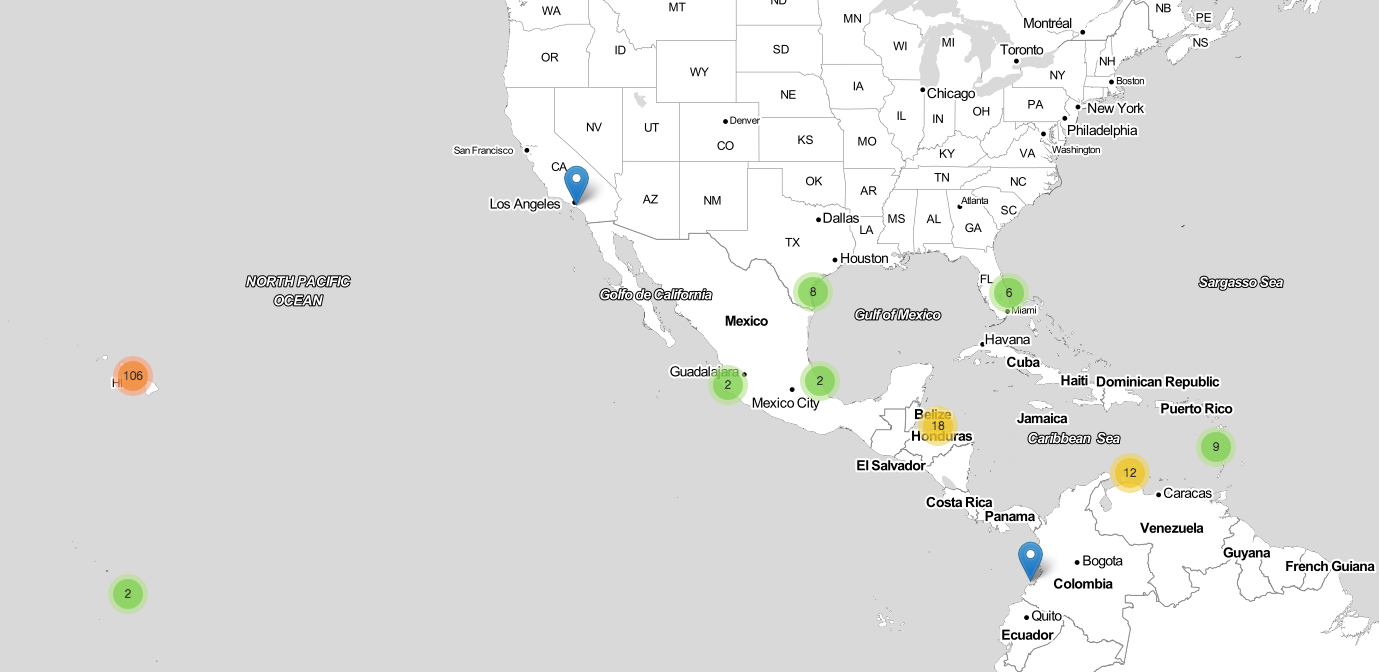Occurrence records map
Drawing on the records in the Global Biodiversity Information Facility (GBIF), we can see where green sea turtles have been found. Other representations, such as range maps, can be added to the map if desired.
| The map below is a static image of data from October, 2016. When browsing this plan on the web, a zoomable, dynamic map with up-to-the-minute data is available. | Live Data Occurrence data |

Nesting Grounds
There is no known nesting by this species in the United States or in any territory under U.S. jurisdiction. The main nesting sites for the East Pacific green turtle are located in the state of Michoacán, Mexico (Colola and Maruata beaches) and in the Galapagos Islands, Ecuador. The Michoacán rookeries support about one third of the East Pacific green turtle population (Cliffton et al. 1982). There are also less important nesting grounds in Mexico (Guerrero, Jalisco, Oaxaca, Chiapas, the islands of Clarion and Socorro) (Márquez 1990) and along the Central American Pacific coastline (Cornelius 1982). Between 1982 and 1989 the estimated East Pacific green turtle nesting population in Michoacán (Mexico) ranged from a high of 5,585 females in 1982 to a low of 940 in 1984 (Alvarado and Figueroa 1990). In October 1976 at least 13 females visited Clarion Island in the Revillagigedo archipelago in Mexico (Awbrey et al. 1984).
At Playa Naranjo, Costa Rica, Cornelius (1976) tagged 80 nesting East Pacific green turtles during 11 September 1971 - 31 March 1972 and estimated the population of nesting females to be between 125 and 175. In the Galapagos Islands an annual average of 1,400 nesting East Pacific green female turtles was registered between 1976 - 1982 (Hurtado 1984). Green (1994) reported that between 1975 and 1980, a total of 6,722 green turtles (including 611 males) was tagged at the nesting beaches and feeding grounds of the Galapagos Islands. There is scant information on numbers of nesting females at other nesting sites.
Insular and Pelagic Range
The East Pacific green is the second-most sighted turtle in the east Pacific during tuna fishing cruises; they are frequent along a North-South band from 15EN to 5ES along 90EW, and between the Galapagos Islands and Central American coast (Inter-American Tropical Tuna Commission, IATTC, unpubl. data). Along the Pacific coast of America, East Pacific green turtles have been reported as far north as British Columbia (48.15EN) (Carl 1955 in Márquez 1990). Loshbaugh (1993) reported a "green turtle" stranding in Homer, Alaska, although it was not known whether the turtle originated from the nesting beaches of Mexico or Hawaii. Adult and juvenile green/East Pacific green turtles have also been reported either from gillnets or from beach strandings as far north as 47E latitude along the Washington coastline (Eckert 1993).
Stinson (1984) reviewed sea turtle sighting records from northern Baja California to Alaska and determined that the East Pacific green turtle was the most commonly observed hard-shelled sea turtle on the U.S. Pacific coast. Most of the sightings (62.0%) were reported from northern Baja California and southern California. The northernmost reported resident population of East Pacific green turtles occurs in San Diego Bay, California, where a small population (about 30) of mature and immature turtles concentrate in the warm water effluent discharged by the San Diego Gas and Electric Company power plant (Stinson 1984; Dutton and McDonald 1990a,b, 1992; McDonald et al. 1995). Based on morphology and preliminary genetic analysis, these turtles appear to have originated from nesting beaches in the east Pacific (Dutton et al. 1994); there is no known sea turtle nesting on the west coast of the United States. Beyond sightings offshore of the western coast of the continental United States, there are no reported encounters with East Pacific green turtles in Hawaii or any territories or pelagic waters under U.S. jurisdiction (see Geographic Scope).
Sighting and stranding reports of "green" turtles along the west coast of the United States are probably mostly of the East Pacific green. It is not known whether they regularly migrate from breeding grounds in Mexico to specific areas along the North American coast, or whether these turtles are vagrants that occasionally stray into more northern waters, perhaps moving with "El Niño" currents. Recently (October 9, 1996), a live, cold-stunned East Pacific green turtle was recovered from Prince William Sound, Alaska (S. Eckert, pers. comm.).
South of the United States, East Pacific green turtles are widely distributed in the coastal waters of Mexico and Central America (e.g., Cliffton et al. 1982; Cornelius 1982, 1986; Alvarado and Figueroa 1990). Along the coast of Mexico and Central America the main aggregations of East Pacific green turtles occur in the breeding grounds of Michoacán, Mexico (August-January) and year-round in the feeding areas such as those located on the west coast of Baja California, in the Gulf of California (Sea of Cortez) and along the coast of Oaxaca. Foraging is also reported from Central America, especially in El Salvador (Márquez 1990). East Pacific green turtles are not restricted to coastal waters, however. After nesting at Colola, Michoacán, on November 17, 1991 a satellite-tagged female traveled northwest and arrived at the Islas Tres Marias archipelago (presumably to feed) within two weeks (R. Byles, U.S. Fish and Wildlife Service [FWS] pers. comm., 1992).
The IATTC reports that during tuna fishing cruises from Baja California to Ecuador and west to almost 150EW, East Pacific greens are seen most frequently in this area; males, females, and juveniles were seen in this area during all times of the year. The algal beds around the Islands of Ferdinanda e Isabel in the Galapagos archipelago are an important feeding ground for the East Pacific green turtles nesting in the Islands (Green and Ortiz-Crespo 1982). The southernmost site reported of East Pacific green turtle distribution is from Desolation Island in Chile (Márquez 1990).